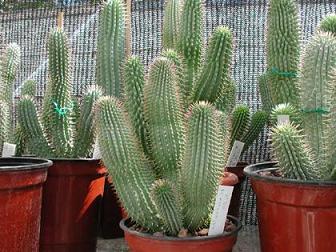South African Hoodia Gordonii the miracle obesity cure?
Hoodia was discovered and used by the San tribe (one of South Africa's oldest tribes) since prehistoric times. They chewed the bitter Hoodia Gordonii twice a day to suppress hunger and thirst during long hunting trips. This plant has recently been translated into a miracle obesity cure, P57, with a market potential of US$6 billion.
The market for a natural appetite suppressant or weight loss product is huge. In the United States alone there are between +/- 50 million clinically obese people and in some developed countries obesity spiraled out of control.
Hoodia looks like an ordinary cactus with thin, thorny
fingers and it grows about 20 inches tall in the reddish sands of southern Africa’s Kalahari Desert.
In 2002 Hoodia Gordonii reversed a worldwide history of exploitation of indigenous peoples. The San tribe could easily have been victims of biopiracy. The particularly disconcerting aspect of this case is that it was a governmental organisation, the Council for Scientific and Industrial Research. The CSIR is an institution that was shaped by the apartheid regime it had served well for 40 years. In 1996 scientists from the CSIR isolated the hunger-suppressing chemical component in Hoodia, now known as P57, and patented it. In 1997, CSIR licensed the UK-based firm Phytopharm to further develop and commercialize P57.
It has been established that P57 works by mimicking the effect that glucose has on nerve cells in the brain in effect fooling the body into thinking it is full, even when it is not, thus curbing the appetite.
The following year, Phytopharm licensed drug giant Pfizer (of Viagra fame) to develop and market P57, with none of the projected royalties being earmarked for the San. A British spokesperson for Pfizer that described P57, said that the San people was "extinct".
The San people felt that their heritage had been plundered and a few years later a claim was launched against the CSIR stating that it had failed to comply with the rules of the Convention on Biological Diversity 1992 (CBD), requiring prior informed consent. Consequently, a "memorandum of understanding" was reached between the parties in March 2002.

At a moving ceremony in Andriesvale, a remote area of the Kalahari, the South African San Council and the Council for Scientific and Industrial Research (CSIR) of South Africa signed an agreement that recognizes and rewards the San as holders of traditional knowledge. The San would receive a mutually agreed percentage of the profit from the CSIR along with offers of education programmes, computer training and employment cultivating the Hoodia cactus plant in the Kalahari.
The above example is a great victory for holders of traditional knowledge, however it represents a rare case where a bilateral agreement on access and benefit sharing has obviated the need for expensive and time-consuming litigation.
The CSIR and the San had to produce an agreement able to withstand international scrutiny. For three years, the South Africa San Council negotiated with the CSIR on behalf of the San in Angola, Botswana, Namibia, Zambia, and Zimbabwe. In a unique arrangement, the San will share profits across borders.
The South African government is considering a draft bill that requires proof of prior informed consent of communities before granting patents for products or elements derived from their traditional knowledge.
At the moment Hoodia Gordonii is extremely difficult to find. The San people believe that in the very near future Hoodia cafes will open all over the world serving Hoodia diet salads and dishes. With the potential money spin-off they will hopefully rid themselves from hundreds of years of oppression, and finally claim their rightful place in the world.